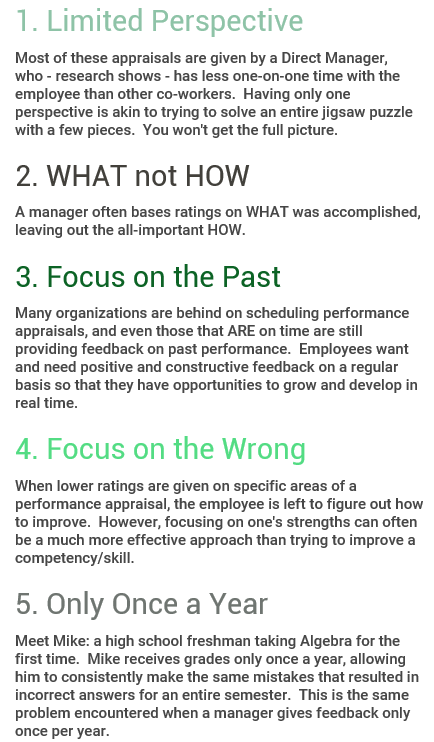The Growth of People is the Highest Calling in Leadership: Why Performance Appraisals are a Waste of Time
By Jennifer Taylor In Business, Info Worth Sharing, Original ThoughtsWhy are traditional performance appraisals still around? Organizations historically have used this process to decide who gets promoted, who gets more money, and who should get cut. Organizations spend millions of hours each year checking the proverbial “Performance Appraisal” box: filling in forms, holding meetings and following an antiquated HR process to dot all of the i’s and cross all of the t’s. With so much time and money invested, companies would like to think that this process is worthwhile. The bottom line? It’s not. In fact, 75% of employees indicate that their performance appraisal doesn’t lead to improved performance.
Additionally, 20% of organizations still use a “forced distribution model,” which forces someone to the bottom – a completely ineffective system in a high-performing organization with exceptional talent!
Consider these additional, compelling statistics:
As the above statistics show, our people – who are our greatest asset – surely deserve more than this sort of quantifiable process, in which one data point from one perspective entirely determines an assigned ranking and future growth. However, we completely understand the importance of metrics and quantifiable data. We know how important it is to gauge employees’ performance and then provide development opportunities that will help each employee grow. We know that one or two development areas that are targeted for improvement can significantly impact one’s overall performance at work. However, conventional performance appraisals are totally missing the mark and are not providing organizations with the vital information they need to truly develop their talent. Here are 5 reasons why conventional performance appraisals don’t work:
The solution? Scrap the Performance Appraisal and ASSESS and help GROW your employees! Sound too good to be true? Worried that it will be too costly? We guarantee that a more progressive approach will save your organization a significant amount of time and money, while providing powerful, positive results. We believe that simpler is better, and have compiled the following list of steps to take:
- Develop a feedback-rich culture that encourages giving and receiving feedback. Feedback processes can be easily implemented and, often, the most effective methods are informal.
- Use a variety of tools to gather feedback, such as short, quick, and easy online assessments coupled with periodic one-on-one conversations.
- Use self-assessments. Most people have a fairly accurate gauge about their own strengths and weaknesses. Allow them to share their thoughts, which can lead to a great dialogue between the employee and their leader.
- Incorporate a multi-rater feedback process in which feedback is provided by the employees’ direct reports, peers, customers, dotted-line managers, direct manager, etc.
- Ensure the feedback is USED and action is taken! We believe that developing an action plan with specific, SMART, and measurable goals is critical. In fact, you’re 42% more likely to accomplish something just by writing it down!
- Set and re-set these goals. We believe that action planning is an ongoing process. Our situation changes throughout the year, so shouldn’t our action plans do the same?
If organizations would transition to this simpler REAL FEEDBACK in REAL TIME model, great things would happen. More honest discussions about current performance could be had, which leads to clearer expectations and an overall shift in culture that supports a growth mindset. Research shows that companies that employ this form of continuous feedback and improvement experience 15% reduced turnover rates. Plus, employees are 4 times more likely to be considered “top performers” when they review and refine personal goals at least quarterly.
So, to answer our first question, “Why are traditional performance appraisals still around?” Answer: We don’t know, but we certainly think they won’t be around for much longer. What are you waiting for?




